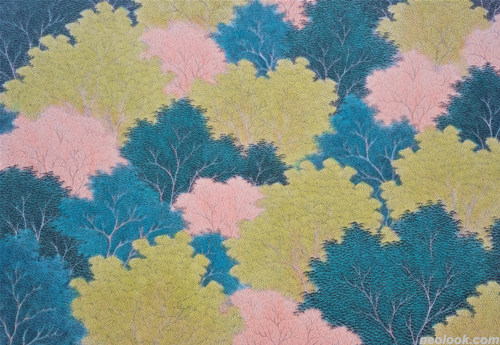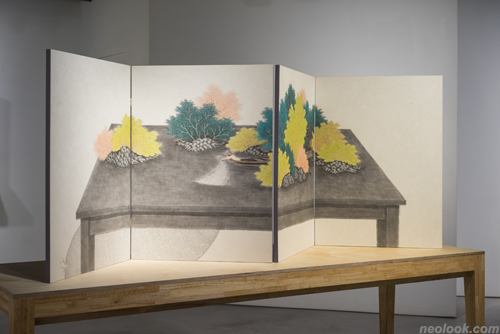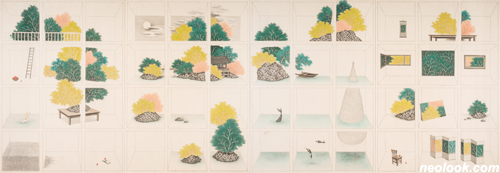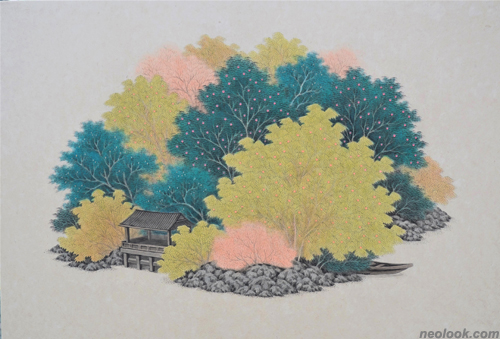- ● homepage
- ● archives
- ● restoration
- ● books
- ● big banners
- ● post board
- ■ neo's search
- ■ about us
- ■ 게재방법 안내
- 개인정보처리방침

- [email protected]
- Tel. 02_335_7922
- Fax. 02_335_7929
- 10:00am~04:30pm
- 월요일~금요일
- 3/3(월) 대체공휴일

문답집 A Dialectic Anthology 問答集
김민주展 / KIMMINJOO / 金玟周 / painting 2017_1201 ▶ 2017_1231 / 월,화,12월24일 휴관
● 위 이미지를 클릭하면 네오룩 아카이브 Vol.20141128e | 김민주展으로 갑니다.
별도의 초대일시가 없습니다.
후원 / 문화체육관광부_서울특별시_서울문화재단
관람시간 / 01:00pm~06:00pm / 월,화,12월24일 휴관
한미 갤러리 서울 Hanmi Gallery Seoul 서울 강남구 신사동 608-12번지 Tel. 070.8680.3107 www.hanmigallery.co.uk
김민주의 섬에 나타난 산수(山水)의 오브제화-전통과의 연결성 ● 김민주 작품에는 상상의 숲이 펼쳐진다. 살구색이나 청록빛이 감도는 크리스마스 트리와 같은 배경이 섬을 이루기도하고, 반인반어의 인어나 얼굴을 삿갓으로 가린 해학적 등장인물이 호기심을 자아내는 오묘한 장면을 연출하기도 한다. 이와 같은 독특한 개성에도 불구하고 김민주의 그림이 전통회화와 강한 연결고리를 갖는 이유는 나무, 바위, 물, 집, 인물 등으로 구성되는 '산수화' 혹은 '산수인물화'의 구성요소를 충실히 지키고 있기 때문이다. 이 몇 가지 기본 요소들을 활용하여 변용·재구성의 묘미를 펼치고, 다양한 변수를 만들어낸다. ● 나무를 묘사하는 수지법(樹枝法)이나, 바위를 그리는 준법(皴法)은 중국회화의 방대한 기법 정리본이라고 할 수 있는 개자원화보(芥子園畵譜)나 조선후기의 회화에 흔히 나타나는 전통적인 기법을 따르고 있다. 수지법의 경우 호초점(胡椒點), 개자점(介字點), 서족점(鼠足點)등의 형태를 활용 및 변형하여 작품에 반영한 예시가 있으며, 주로 협엽(夾葉: 윤곽이 있는 잎)의 형태로 화면에 그려낸다. 바위의 경우는 피마준(披麻皴)과 선염(渲染)을 적절히 섞고 음영법을 살짝 가미하여 자신만의 기법을 만들었다고 할 수 있다.

- 김민주_사유의 숲_장지에 먹, 채색_66×96cm_2017
또한 나무나 바위의 채색에 있어서 청록과 석록(石綠: 에메랄드색)을 지속적으로 사용하는 것은 청록산수화의 계보와 연결될 수 있는 가능성을 만들어낸다. 당대(唐代) 이사훈(李思訓), 이소도(李昭道) 부자가 형성했던 청록산수의 원류나, 구한말 안중식의 「도원문진도(桃園問津圖)」, 근대기 김기창의 「바보산수」시리즈 등을 언급하며 그 연관성을 설명하기에 큰 무리가 없는 것이다. 김민주의 2009년작 「어락원」을 보면 청록산수의 형식이 강하게 나타나며 현재까지 이어지는 작품들에서도 산석(山石)의 묘사나 청록·석록의 사용을 통해 직간접적으로 그 영향이 나타나고 있다. 이와 같이 산수화의 기본 구성요소를 갖추고 있다는 점, 전통회화의 수지법을 차용한다는 점, 청록을 쓴다는 점 등은 괴짜 캐릭터나, 독특한 상상력을 마음껏 펼치면서도 스스로의 작품을 전통 '산수화' 혹은 '산수인물화'의 영역 안으로 남겨둘 수 있는 근거를 만들어 주었다.

- 김민주_문답집展_한미갤러리_2017
주관적 해석과 산수의 비중 ● 작가가 전통의 요소들을 주관화·현대화 하는 과정에서 가장 두드러지게 나타나는 조형적 특징은 화면 안에서 산수가 차지하는 비중의 변화이다. 산수의 크기를 그림의 폭 안에서 어떻게 조정하느냐에 따라 산수와 산수 외의 요소들(집, 인물, 기물)의 관계형성이 달라진다. 이러한 산수 크기의 조정은 김민주 작품 시리즈에 드러나는 중요한 특징 중의 하나이다. ● 산수의 비중이 대부분이고 인물과 집이 작게 표현된 형식은 2014년 작 「사유의 숲」과 「물길」, 2017년 작 「심경」 등에서 볼 수 있다. 배경을 잘라낸 구도의 방식이 다소 현대적임에도 불구하고 비교적 전통 산수화에서 나타나는 자연과 집의 비율을 비슷하게 지키고 있다. 자연 속에 유유자적하며 무위자연(無爲自然)하고자 했던 시정(詩情)의 공간과 자연주의 사상이 나타난다.

- 김민주_사유문답-책상 위 산수_장지에 먹, 채색_72×318cm_2017_부분
그 외에 건축물이 극대화되어 커지고 그 안으로 산수화가 들어오게 된 시리즈가 있다. 2011년 작 「인생은 아름다워」, 2012년 작 「휴가」에서 그러한 예시가 나타난다. 카메라 앵글로 클로즈업을 한 듯한 보편적 풍경화의 구도는 근대기 실경산수화에 나타난 특징이라고 할 수 있다. 이러한 형식에서 더욱 나아가 작가는 단독주택과 같은 건축물들을 과장하고 확대한다. 때로는 외벽이 생략되고 건물의 내부가 그대로 들여다보이기도 한다. 그럼에도 불구하고 간접적으로나마 실경(實景)의 개념이 떠오르는 이유는 바로 한국의 주택가에서 흔히 볼 수 있는 집들의 모습을 차용하여 그리고 있기 때문일 것이다. 한국인에게는 누구에게나 익숙한 건축물들과 작가의 상상력으로 재구성된 자연물의 결합은 '실경'과 '작가적 사의(寫意)'의 결합이라고 할 수 있다. ● 또 한 가지 화면에서 주목해야 할 점은 건물들에 다른 산수부분과는 다르게 3차원적 투시도법을 그대로 적용했다는 점이다. 투시도법뿐만 아니라 산수에 비해 건축물의 비중이 커진 이유는 산과 강에 둘러싸여 살았던 전통사회와 달리 고층건물에 둘러싸여 살아가는 대도시 문화를 그대로 반영하는 비유법이다. 산점투시 혹은 투시도법을 아예 무시하고 패턴화한 듯한 산수 부분이 사실적인 건축물의 투시도법과 대비되며 전통과 현대를 동시에 반영하는 조화를 이룬다.

- 김민주_사유문답-책상 위 산수_장지에 먹, 채색_72×318cm_2017_부분
산수의 오브제화 ● 이번 전시에서 과거의 김민주 회화 형식에 비교하여 새롭게 나타난 점이 있다면, 오브제, 설치, 공간에 대한 형식의 실험이다. 마르셀 뒤샹이 오브제를 전시장 안으로 가지고 들어온 시기를 기점으로 하여 현대미술에서는 설치미술과 공간의 개념이 점점 중요하게 되었다. '오브제-설치-공간'의 개념은 따로 떼어 분리할 수 없는 관계와 흐름을 형성해 왔다고 할 수 있는데, 이번 전시에서 이에 대한 자각을 보여주는 조형방식이 나타났다. 흥미로운 점은 새로운 시도들이 전통예술의 주관화·현대화의 연장선상에 있다는 점이다.

- 김민주_문답집展_한미갤러리_2017
2017년도 작품 「사유문답-책상 위 책상 속 산수」를 보면, 테이블 위에 병풍 형식의 화첩이 놓여 있다. 산수화라는 장르가 마치 오브제화 되어 테이블 위에 올려진 느낌이다. 지그재그 형식의 화첩은 병풍과 마찬가지로 접어 두었다가 필요한 공간에 세워놓을 수 있는 형식이라는 점에서 설치의 가변성을 내포하고 있다. 고전적인 박물관에서 사용하는 작품보존대나 벽에 그림을 거는 형식을 벗어나, 테이블을 제작하여 그 위에 설치작품이나 오브제를 놓아두는 형식은 현대미술관이나 갤러리에서 익숙하게 볼 수 있는 설치방법인데 김민주는 이를 차용하고 있다. 그런데 그 위에 다시 공간적 가변성의 특징을 가진 병풍을 올려놓아 설치 방법의 작가적 개성을 드러냈다. 물론 그 안에 다시 김민주의 그림이 그려지면서 이 작품은 여러 겹의 형식을 복합적으로 갖추게 되었다.

- 김민주_사유문답-책상 위 책상 속 산수_장지에 먹, 채색_72×212cm_2017
「사유문답-책상 위 산수」는 이러한 설치 아이디어를 직접 화면에 기록한 것 같은 평면작품이다. 축소된 산수화가 섬과 같은 형상으로 테이블 위에 놓여 있다. 돌의 예술성 찾아 수집했던 전통문화, 수석의 한 부류라고 할 수 있는 산수경석(山水景石)이 문득 떠오른다. 인위적인 가공 없이 '선택'의 개념만이 극대화 되어있는 독특한 수집문화는 현대미술에서 오브제를 활용하는 방법과 닮아있다. 그렇기에 산수를 오브제화 한 것 같은 표현방식이 절묘한 비유로 느껴진다. 테이블을 묘사하거나 시각적으로 설명하지 않고 단순하게 선으로만 표현한 점은 바로 테이블 위에 산수를 올려놓겠다는 개념을 설명하는 프로포절proposal 형식으로 느껴지기도 한다. ● 또 다른 새로운 시도 중에는 책거리(冊巨里)·책가도(冊架圖)의 구도를 활용한 작품 「사유문답-진열된 산수」가 있다. 책거리는 책을 주제로 한 전통회화의 한 형식으로 장식장에 진열된 책이나 서가에 있을 법한 기물들을 함께 그린 그림이다. 책 외에도 청동기, 도자기, 문방구, 화병, 수석, 과일 등의 다양한 기물이 같이 그려지곤 했다. 김민주가 장식장(책장)에 물건을 놓아두듯이 축소된 산수화를 그린 점은 산수자연을 오브제로 인식했음을 보여주는 또 다른 증거이다.

- 김민주_사유문답-진열된 산수_장지에 먹, 채색_97×135cm_2017
회화에서 과거의 미술사나 전통을 어떠한 방법으로 재해석을 했는지 그 자체가 그림의 주제가 되는 경우가 있다. 김민주는 그러한 부류의 작품을 만들어내는 작가로 분류할만하며 특히 '산수화', '산수인물화'를 재해석해온 작가로 볼 수 있다. 이번 전시에서는 전통회화의 요소들을 설치·공간·오브제의 개념을 활용하여 알맞게 해석하고 있다. 필자가 언급한 '산수의 오브제화'는 작품의 제목에서 '섬'으로 비유되어 나타나기도 한다. 섬은 주변과의 관계를 끊고 고립된 느낌을 줄 수도 있지만, 김민주의 작품에 나타난 섬 형식의 산수는 배를 타고 다양한 세계로 나아갈 수 있는 가능성을 품고 있는 '섬'이 아닐까 생각해본다. 마치 전통과 현대의 간극을 연결하는 다양한 방법을 보여주려는 듯 말이다. 마침 그림에 자주 등장하는 고기잡이 배는 섬에서 언제든지 커다란 바다로 나가거나 다른 육지로 갈 수 있는 가능성을 보여주기 위해 그려진 것이 아닐까? ■ 김은형

- 김민주_사유문답-진열된 산수_장지에 먹, 채색_각135×97cm_2017
Translation, Editing : Doo Hee Chung, Aaron Cumberledge Landscapes Becoming Objects on the Islands of Min Joo Kim - Connections with Traditions ● Min Joo Kim’s work reveals the forest of her imagination. A backdrop of a Christmas tree with blue-green and apricot-colored lights becomes an island, and characters like half-human, half-fish mercreatures or a humorous person whose face is covered by a traditional bamboo hat produce a mysterious, curious scene. Despite their unique personality, Min Joo Kim’s paintings are strongly rooted in traditional paintings, because they faithfully observe elements of shan shui (traditional Chinese landscape painting) and shan shui renwu (traditional Chinese landscape and figure painting) in their composition of trees, rocks, water, houses, and figures. Utilizing these basic elements, the artist transforms and reconstructs them to create diverse works. ● The techniques used in the depiction of trees and rocks are based on the traditional techniques found in the Manual of the Mustard Seed Garden (a tome of Chinese painting instruction) that were also commonly used in paintings from the late Joseon Dynasty. In the case of the trees there are examples of several techniques—such as the pepper dots stroke, the Jie dots stroke, the Rat’s-foot dots stroke, and the outlined leaves technique—being utilized and transformed in Kim’s work. In the case of the rocks, it could be said that the artist made her own technique by mixing the traditional techniques of the hemp-fiber texture stroke, staining by smearing, and shading. ● In addition, the continuous use of blue-green and malachite-green (emerald green) in the coloring of the trees and rocks makes it possible to link them with the lineage of blue-green shan shui. The origins of the blue-green shan shui style are found in the work of the Li family (Li Sixun [李思訓] and his son Li Zhaodao [李昭道]) during the Tang Dynasty. It was later modified in Peach Blossom Spring by Jung Sik An in the late Joseon period and the Idiot Landscape series by Ki Chang Kim in the modern period. Seeing the connection between these works and Kim’s is not difficult. In Kim’s Fish Paradise (2000), the blue-green shan shui style makes a distinct appearance, and the style’s influence continues to be seen (directly and indirectly) in the depiction of the mountain rocks and the use of blue-green and malachite-green in subsequent works. The fact that Kim’s work contains basic elements of shan shui (utilizing traditional techniques for depicting trees and rocks), and the fact that it employs the color blue-green makes it possible to classify it as traditional shan shui or shan shui renwu. On the other hand, her use of quirky characters reveals her unique imagination and originality. Subjective Interpretations and the Proportions of Shan Shui ● The most prominent method by which Kim’s works subjectify and modernize traditional forms is the change in the proportions of the natural landscapes in her paintings. The relationship between the natural landscape and the other elements (houses, people, objects) changes depending on their relative sizes within the canvas. This variation in the size of the natural landscape is one of the most important features of Min Joo Kim’s work. In Forest of Meditation (2014), Waterway (2017), and Scenery of the Heart (2017), the natural landscape is large, and other elements (like human figures and houses) are small. Although the composition of the background is somewhat contemporary, it maintains a ratio between the natural landscape and the other elements that is more or less the same as in shan shui. This create an open space for poetry and spontaneous thought that allows one to become one with nature. ● Kim also painted a series in which buildings are massive, and landscapes exist wholly or partially within the buildings. Two examples are Life is Beautiful (2011) and House of Rest (2012). In the modernization of realistic landscape painting, compositions from a more close-up perspective have emerged. Furthering this trend, Kim exaggerates and enlarges buildings such as single-family houses. Sometimes the exterior walls are omitted, and the insides of the buildings can be seen. Nevertheless, realism is indirectly brought to mind, because the buildings are based on the houses that are often seen in Korean residential areas. For Koreans, the combination of buildings that are familiar to everyone and natural objects reconstructed by the imagination of an artist is a combination of “the real” and “the artistic spirit.” ● It is also interesting to note that the buildings in Kim’s paintings are depicted with a three-dimensional perspective, unlike the other parts of the landscape. Not only are they rendered in three dimensions, but they take up a much larger portion of the painting than buildings in traditional shan shui. The increase in the size of the buildings compared to shan shui is a metaphor that reflects a metropolitan culture where one is surrounded by high-rise buildings, unlike the more traditional society that lived surrounded by mountains and rivers. A landscape made of repeated patterns in a flattened perspective is contrasted with a realistic architectural perspective, so that the work reflects both tradition and modernity. Landscapes Becoming Objects ● A new idea in this exhibition, compared with Kim’s past work, is an experimentation with objects, installation, and space. The concept of installation art and the importance of the display space has been growing ever since Marcel Duchamp brought his object into the exhibition hall. This concept of “object—installation—space” has formed a relationship and a connection that cannot be separated. In this exhibition, Kim shows an acute awareness of this. This new initiative is an interesting extension of her subjectivation and modernization of traditional arts. ● In the work A Dialogue of Thoughts: Landscape on a Table on a Table in 2017, a painting on a folding screen is set on a table, which gives the impression that the entire genre of landscape painting has become an object and been put on a table. The zigzagging of the screen grants a variability to the shape, because it can be folded into different dimensions and it can be placed in a specific space. Classical art museums display works by hanging them on a wall or displaying them on a stand, but modern art museums commonly use tables with installation artworks or art objects on them for displays. Min Joo Kim borrows the latter display type, then adds her folding screen with its features of spatial variability, revealing her unique sense of display. Of course, the entire installation consists of not only these layers of display, but also Kim’s actual painting on the screen. ● A Dialogue of Thoughts: Landscape on a Table is a flat work that seems to include the ideas of installation art within the painting. A shrunken landscape painting in the shape of an island is placed on a table. It is reminiscent of landscape stones, like suseok (Korean viewing stones), and the traditional culture of the people who collected these stones for their aesthetics, suddenly comes to mind. A culture of collection that focused on only “choosing” an object and not making any man-made alterations to it resembles the using of found objects in contemporary art. This makes the landscape into an incredible, metaphorical example of contemporary art. The fact that the table is neither fully drawn nor visualized, but is expressed simply with lines, gives merely the vague suggestion of the idea that the landscape in on a table. ● Among other new efforts, there is a work called A Dialogue of Thoughts: Landscape on Display, which uses the composition of Chaekgeori or Chaekgado. Chaekgeori is a traditional painting genre featuring books—and sometimes other objects—sitting on a book shelf. These other objects can include bronzeware, ceramics, stationery, vases, suseok, fruit, and various other things. The fact that Min Joo Kim has placed objects on a bookshelf is yet more proof that she recognizes landscapes as objects. ● In some cases, the reinterpretation of art history or traditions may be the subject of the painting itself. Min Joo Kim can be classified as an artist who produces such works, especially in her reinterpretation of shan shui or shan shui renwu. In this exhibition, elements of traditional painting are adroitly reinterpreted using the concepts of object, installation, and space. The landscapes that become objects in Kim’s work are sometimes referred to as “islands” in the artist’s titles. Although islands may not have a strong relationship with the surrounding lands and may feel isolated, I wonder if the island-shaped landscapes shown in Kim’s works grant the possibility of travelling to other worlds by boat. That would suggest a variety of ways to bridge the gap between tradition and modernity. I wonder if the fishing boats that often appear in her paintings were put there to show the possibility of heading out to the open sea at any moment and going to another land. ■ Eun Hyung Kim
Vol.20171203h | 김민주展 / KIMMINJOO / 金玟周 / painting

